
Alopecia is a medical term used to describe the partial or complete loss of hair on the scalp or other parts of the body. It is a condition that can affect both men and women and can occur at any age. The word “alopecia” originates from the Greek word “alopex,” which means “fox,” and it was first used in reference to a disease in foxes that caused hair loss.
Categories:
Alopecia can be further divided into two categories based on whether or not there is scarring present:
Non-Scarring Alopecia (Non-Cicatricial Alopecia):
In this type of alopecia, there is no scarring or damage to the hair follicles. Hair follicles are still capable of producing hair, but for various reasons, they may go into a resting phase or produce thinner, shorter hair. Some common types of non-scarring alopecia include:
- Androgenetic Alopecia (Male or Female Pattern Baldness)
- Alopecia Areata
- Telogen Effluvium
- Trichotillomania (Hair-pulling disorder)
- Traction Alopecia (Hair loss due to repetitive pulling or tension on the hair)
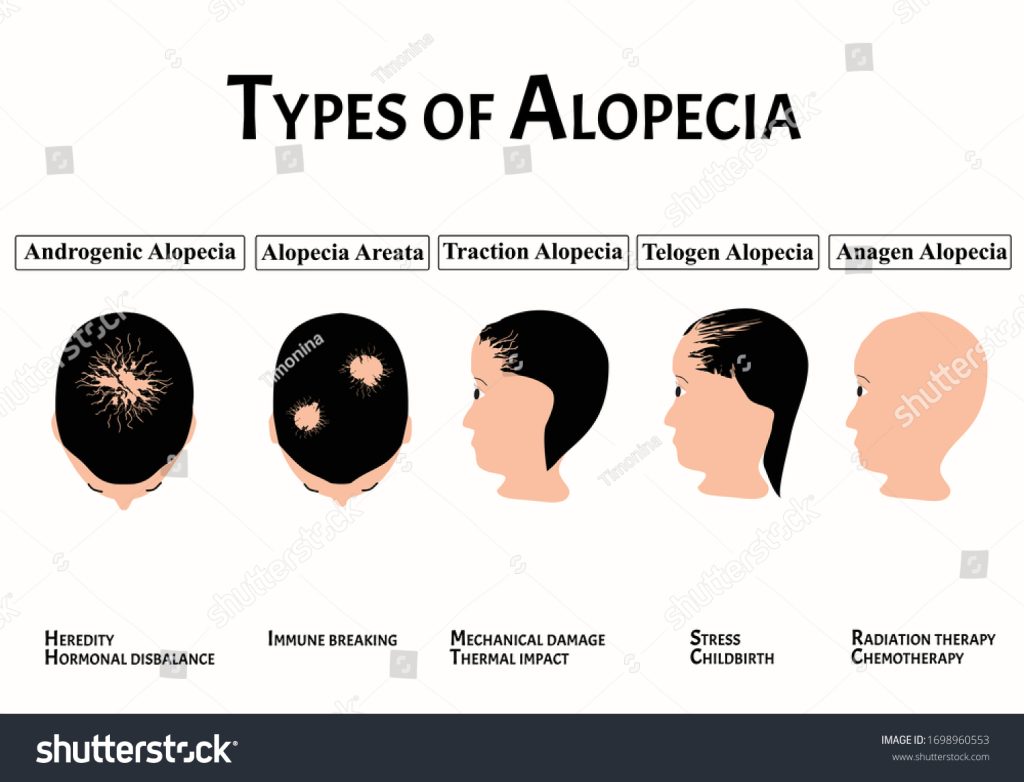
Scarring Alopecia (Cicatricial Alopecia):
In scarring alopecia, there is damage or destruction to the hair follicles, resulting in irreversible hair loss. The hair follicles are replaced by scar tissue, which prevents the regrowth of hair. Scarring alopecia is typically caused by inflammation or other underlying conditions. Some common types of scarring alopecia include:
- Central Centrifugal Cicatricial Alopecia (CCCA)
- Discoid Lupus Erythematosus (DLE)
- Frontal Fibrosing Alopecia (FFA)
- Lichen Planopilaris (LPP)
- Folliculitis Decalvans
Stages of Alopecia:
Hair loss can occur due to various reasons, including genetic factors, medical conditions, hormonal changes, and external factors. Here are the general stages of hair loss:
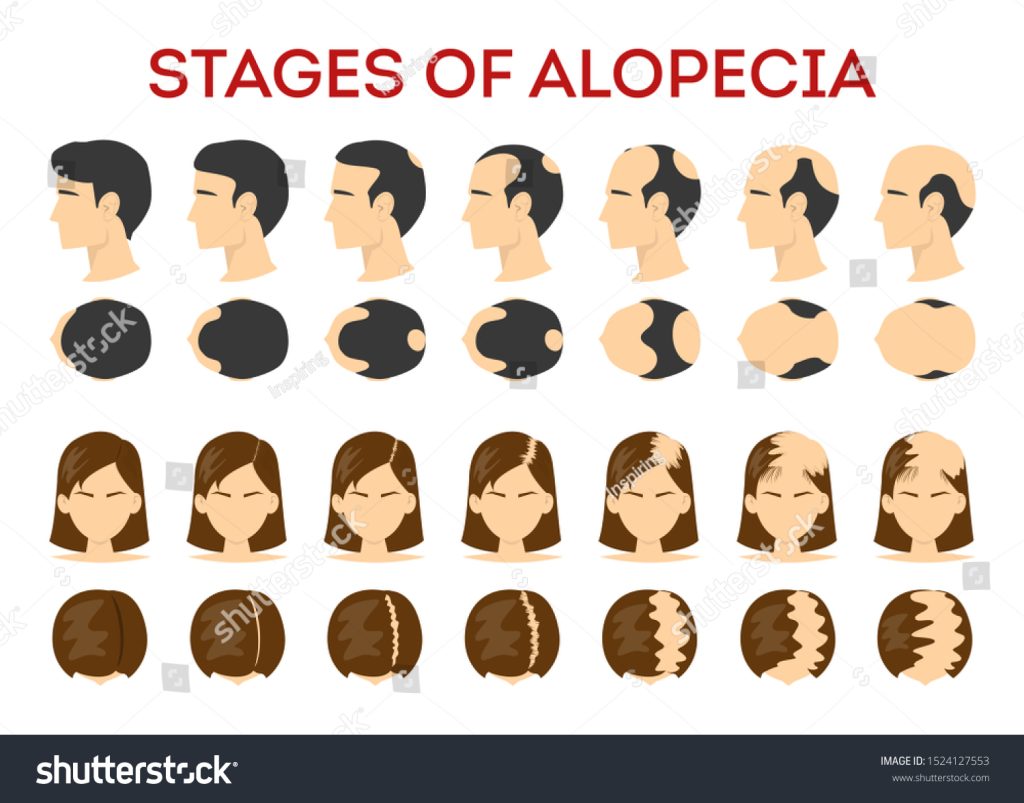
Normal Hair Growth:
In this stage, the hair follicles are active, and there is healthy hair growth. The scalp has a full head of hair without any noticeable thinning or loss.
Initial Hair Thinning:
The first stage of hair loss is often characterized by minimal thinning of the hair. The scalp may start to become more visible due to the reduction in hair density. Hair shedding may also increase slightly.
Progressive Hair Thinning:
Hair thinning becomes more noticeable and widespread across the scalp. The scalp becomes more visible, and there is a significant reduction in hair volume and density. The thinning may be more prominent in specific areas, such as the crown or hairline.
Advanced Hair Thinning:
Hair loss becomes more pronounced, with significant thinning across the entire scalp. The scalp becomes more visible, and there is a noticeable decrease in hair coverage. The hair strands may become finer and weaker.
Partial Baldness:
This stage is characterized by partial baldness, where large areas of the scalp have little to no hair. The remaining hair may be sparse, and the scalp is clearly visible.
Near Total Baldness:
Near total baldness refers to a stage where only a limited amount of hair remains on the scalp. Bald patches are prominent, and the scalp is predominantly exposed.
Complete Baldness:
Complete baldness, also known as alopecia totalis, refers to the total absence of hair on the scalp. The entire head is bald, and no hair growth is present.
It’s important to note that the stages of hair loss can vary depending on the underlying cause and individual factors. Different types of hair loss, such as androgenetic alopecia, alopecia areata, and traction alopecia, may have specific patterns and stages of progression.
Causes Of Alopecia:
The causes of alopecia can vary depending on the type of alopecia. Here are some common causes associated with different forms of alopecia:
Androgenetic Alopecia (Male or Female Pattern Baldness):
- Genetic factors: A family history of androgenetic alopecia increases the risk.
- Hormonal factors: Imbalances in hormones, particularly androgens like dihydrotestosterone (DHT), can contribute to hair loss.
- Aging: Hair follicles may become more sensitive to hormones with age.
Alopecia Areata:
- Autoimmune factors: The immune system mistakenly attacks the hair follicles, causing hair loss.
Genetic predisposition: Family history of autoimmune diseases or alopecia areata increases the risk.
- Triggers: Emotional or physical stress, viral infections, or other environmental factors can trigger alopecia areata.
Telogen Effluvium:
- Physical or emotional stress: Surgery, severe illness, childbirth, emotional trauma, or extreme weight loss can disrupt the hair growth cycle.
- Hormonal changes: Hormonal fluctuations after giving birth, stopping or starting birth control pills, or thyroid imbalances can trigger telogen effluvium.
- Nutritional deficiencies: Inadequate intake of essential nutrients, such as iron, zinc, or vitamins, can contribute to hair loss.
Scarring Alopecia (Cicatricial Alopecia):
Inflammatory conditions: Conditions like discoid lupus erythematosus (DLE), lichen planopilaris (LPP), or folliculitis decalvans can cause scarring alopecia due to inflammation.
Infections: Certain fungal or bacterial infections of the scalp can lead to scarring alopecia.
Trauma: Physical trauma, such as burns or injuries, can cause scarring and permanent hair loss.
Other factors that can contribute to various forms of alopecia include certain medications (e.g., chemotherapy drugs), hormonal imbalances (e.g., polycystic ovary syndrome), autoimmune diseases, and underlying medical conditions.
Sign and Symptoms:
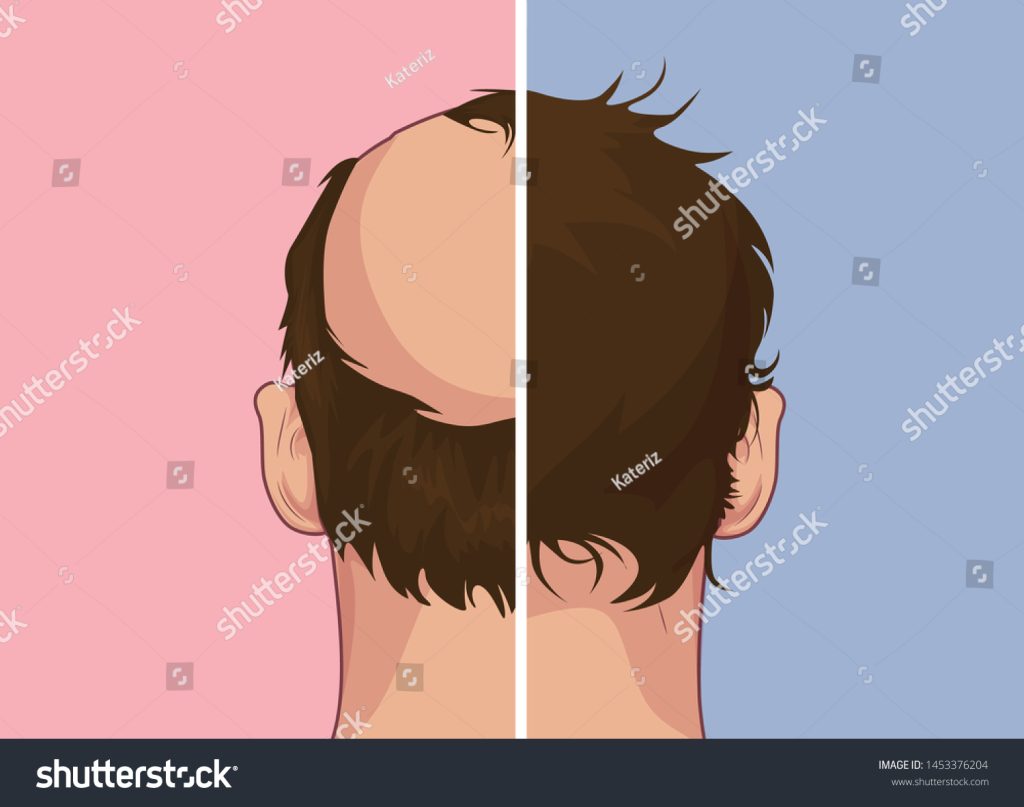
The signs and symptoms of alopecia can vary depending on the type of alopecia and its severity. Here are some common signs and symptoms associated with different forms of alopecia:
Androgenetic Alopecia (Male or Female Pattern Baldness):
- Gradual hair thinning, usually starting at the hairline or crown of the head.
- Receding hairline in men.
- Thinning of hair on the top of the head in women, often with the preservation of the frontal hairline.
- Increased visibility of the scalp.
Alopecia Areata:
- Sudden onset of one or more round or oval-shaped bald patches on the scalp or other areas of the body.
- Smooth, hairless patches with no scaling or redness.
- Regrowth of hair may occur spontaneously or with treatment.
- In severe cases, it can progress to complete baldness on the scalp (alopecia totalis) or loss of all body hair (alopecia universalis).
Telogen Effluvium:
- Diffuse hair shedding or thinning on the scalp.
- Increased hair loss during brushing, showering, or gentle tugging.
- Usually occurs a few months after a triggering event, such as surgery, illness, childbirth, or emotional stress.
- Generally, the condition resolves on its own once the underlying trigger is addressed.
Scarring Alopecia (Cicatricial Alopecia):
- Progressive hair loss accompanied by inflammation, redness, and itching.
- Formation of smooth, shiny, and scarred areas on the scalp.
- Destruction of hair follicles, leading to permanent hair loss.
- Sometimes, the scalp may have visible signs of inflammation, such as scaling or pustules.
It’s important to note that the signs and symptoms of alopecia can vary from person to person, and a proper diagnosis by a dermatologist or healthcare professional is essential for accurate identification and appropriate management of the condition.
Risk Factors of alopecia:
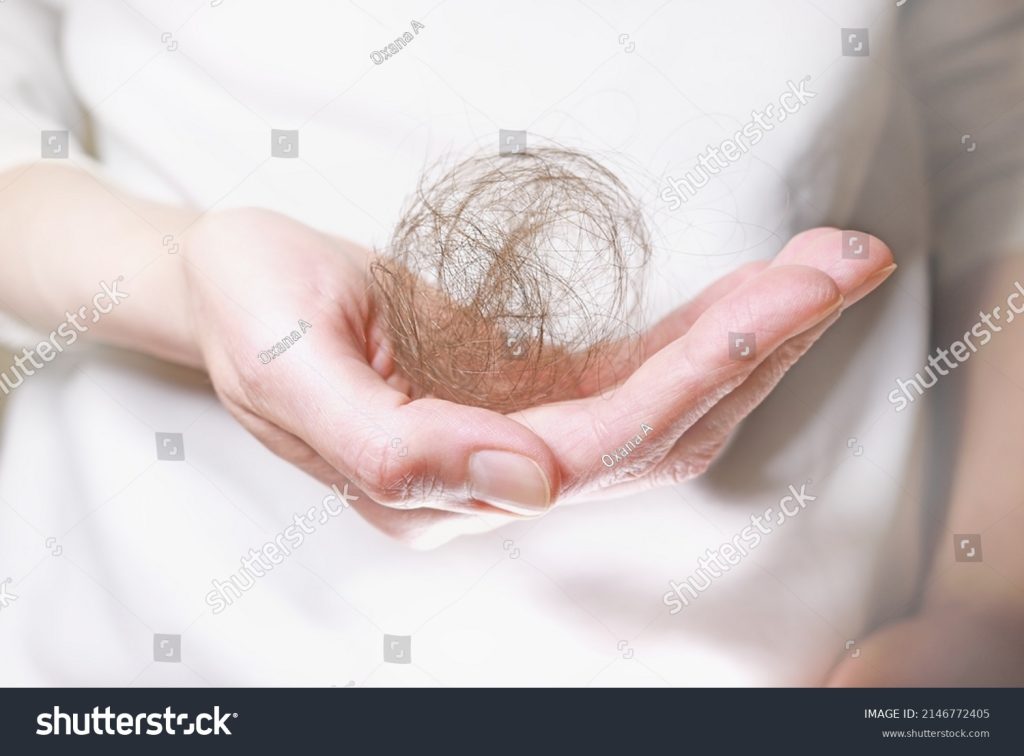
While the exact causes of alopecia are not fully understood, several risk factors have been identified that can contribute to the development of different types of alopecia. Here are some common risk factors associated with alopecia:
- Family History
- Age
- Hormonal Changes
- Autoimmune Disorders
- Psychological Stress
Medical Conditions: Certain medical conditions, such as hormonal disorders (e.g., polycystic ovary syndrome), scalp infections, skin conditions (e.g., psoriasis), or chronic illnesses, may increase the risk of developing alopecia.
Diagnostic testing:

The diagnosis of alopecia involves a comprehensive evaluation by a dermatologist or healthcare professional specializing in hair disorders. Here are the typical steps involved in the diagnosis of alopecia:
- Medical History.
- Physical Examination
- Pull Test
- Scalp Biopsy
- Blood Tests
Additional Tests: In some cases, additional tests may be performed to rule out other potential causes or to further evaluate specific conditions. These may include trichoscopy (microscopic examination of the hair and scalp), cultures for fungal or bacterial infections, or autoimmune antibody tests for conditions like alopecia areata.
Treatment:
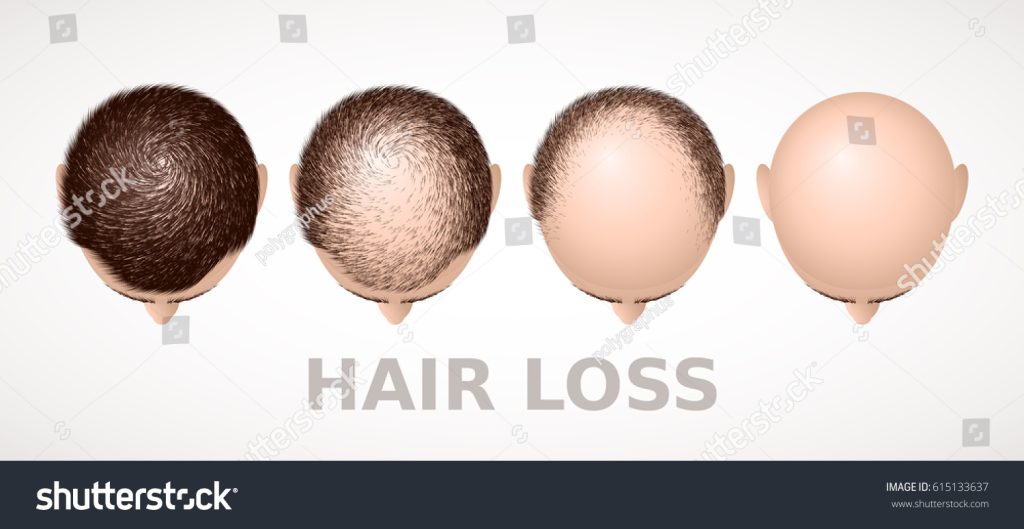
The treatment of alopecia depends on the type and severity of the condition. While there is no known cure for most forms of alopecia, there are various treatment options available to manage the condition and promote hair regrowth. Here are some common treatment approaches:
Medications:
- Minoxidil: This over-the-counter medication is commonly used to treat androgenetic alopecia. It is applied topically to the scalp and can help stimulate hair growth and slow down hair loss.
- Finasteride: This prescription medication is primarily used to treat male pattern baldness. It works by blocking the conversion of testosterone to dihydrotestosterone (DHT), which is responsible for hair follicle miniaturization.
- Corticosteroids: In the case of alopecia areata, corticosteroids can be injected into the affected areas or applied topically to help suppress the immune response and promote hair regrowth.
- Other medications: In certain cases, oral medications like oral corticosteroids, immunosuppressants, or topical immunotherapy agents may be prescribed depending on the type and severity of alopecia.
Topical Treatments:
- Anthralin: It is a topical medication used in the treatment of alopecia areata. It helps to modulate the immune response and promote hair regrowth.
- Topical corticosteroids: These are commonly used in the treatment of various forms of alopecia to reduce inflammation and promote hair regrowth.
- Hair Transplantation: Hair transplantation involves surgically transferring hair follicles from areas of the scalp with normal hair growth to areas affected by alopecia. It is commonly used for androgenetic alopecia or scarring alopecia.
- Scalp Micropigmentation: This procedure involves tattooing tiny dots on the scalp to create the appearance of hair follicles, giving the illusion of a shaved head or fuller hair.
Wigs, Hairpieces, and Camouflage Techniques: These options can be considered for individuals who prefer non-medical interventions to cover hair loss.

